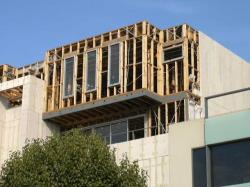Timber set to rise to eight storeys (and cut costs) under National Construction Code changes in May
posted: 08/Feb/2016

Until now, the choice of construction materials for mid-rise urban developments has been limited to a traditional palette that excluded timber – however changes to the National Construction Code (NCC) from 1 May will enable timber buildings of up to eight storeys without the need for expensive Alternative Solutions to gain approval.
These changes to the code will deliver a wide range of benefits to local residents, property buyers and the domestic building industry. They also bring Australia up to pace with much of the rest of the world – so that the building property industry can take advantage of the environmental and cost benefits of domestic timber construction.
Wood can offer quicker build times, with less noise and disruption for neighbours. It can also offer innovative design approaches.
 James Fitzpatrick of Sydney architects Fitzpatrick and Partners said: “This is an exciting step forward for architects and their clients. It not only gives us new material options to create innovative design solutions for our clients, but it also enables us to deliver more environmentally advantaged and sustainable developments.
James Fitzpatrick of Sydney architects Fitzpatrick and Partners said: “This is an exciting step forward for architects and their clients. It not only gives us new material options to create innovative design solutions for our clients, but it also enables us to deliver more environmentally advantaged and sustainable developments.
“Ultimately, the code change will potentially mean quicker, more cost effective and environmentally friendlier construction of apartment, office and hotel buildings.”
The changes apply to both modern engineered timbers and traditional timber frame. Engineered timbers made from sustainable plantation timber are used in Lend Lease’s Forte development in Melbourne’s Docklands – one of the world’s tallest modern residential timber buildings. Traditional timber frame is used in The Green, an apartment complex, in Parkville by Frasers Property Australia (formerly Australand).

Construction of The Green, in Parkville, Melbourne. Photo source: Frasers Property Australia
In an article in the Fifth Estate in May 2014, the developers of The Green said average build costs per apartment were 25 per cent less than in a conventional apartment construction.
Preliminary economic modelling indicates potential savings in the order of up to 15% depending on build type, primarily due to shorter construction times. The modelling also suggests net benefits to the Australian economy over 10 years of approximately $103 million; comprising $98.2 million in direct construction cost savings, $3.8 million in reduced compliance costs; and $1 million in environmental benefits.
The code change in more detail
Currently, timber building systems are restricted to three storeys under the NCC’s deemed-to-satisfy provisions, with taller buildings requiring an ‘alternative solution’ to be designed and documented to gain approval. Alternative solutions, while practical on some larger projects, are generally too costly for smaller jobs.
The new code creates a voluntary prescriptive performance (previously known as a deemed-to-satisfy solution) for the use of timber building systems in Class 2 (apartments), Class 3 (hotels) and Class 5 (office) buildings up to 25 metres in effective height.
The new solution covers both traditional timber framing and innovative massive timber systems – such as cross laminated timber (CLT) and Glulam – and comprises the use of appropriate layers of fire resistant materials and sprinkler systems.
Previous Articles
Choosing the right type of timber should ensure your fence will last longer than you own the home!
If you've got your hammer and nails ready but not sure what else to do, start here!
Timber is a preferred material for landscaping purposes. Retaining walls in particular contribute significantly to the surroundings when constructed from timber.